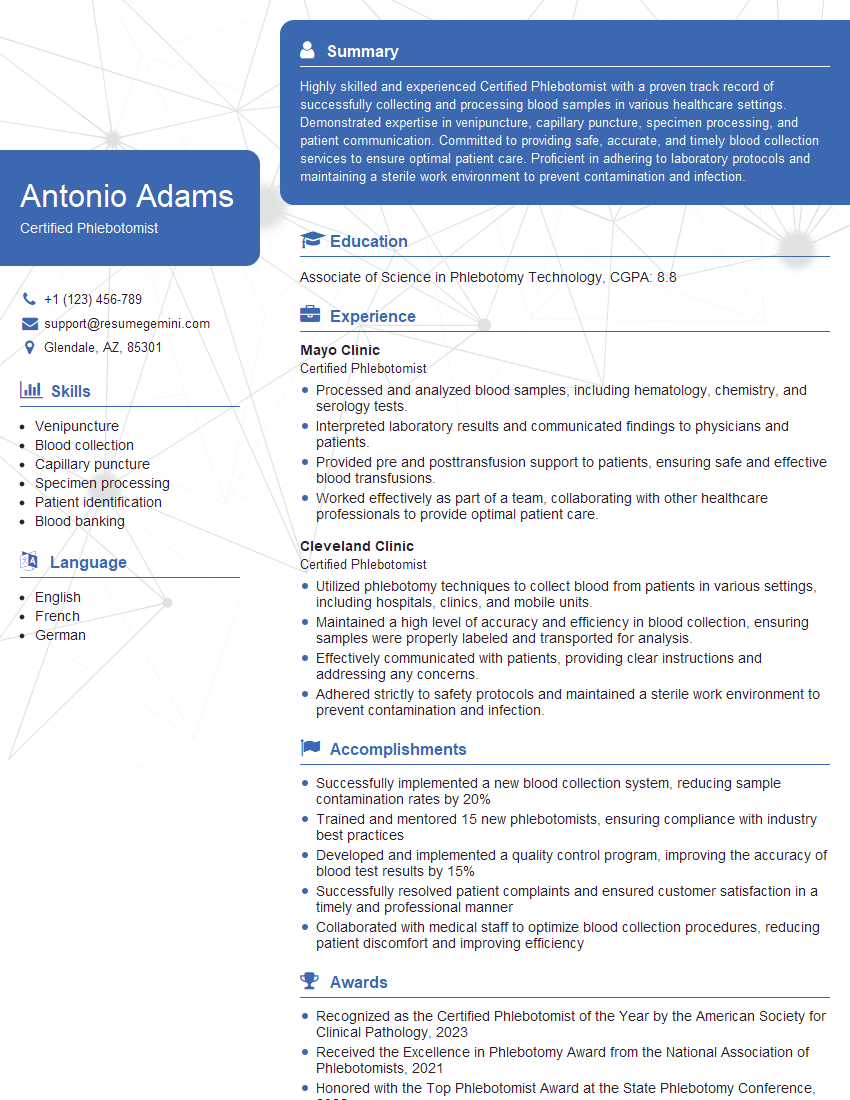Are you a seasoned Certified Phlebotomist seeking a new career path? Discover our professionally built Certified Phlebotomist Resume Template. This time-saving tool provides a solid foundation for your job search. Simply click “Edit Resume” to customize it with your unique experiences and achievements. Customize fonts and colors to match your personal style and increase your chances of landing your dream job. Explore more Resume Templates for additional options.

Antonio Adams
Certified Phlebotomist
Summary
Highly skilled and experienced Certified Phlebotomist with a proven track record of successfully collecting and processing blood samples in various healthcare settings. Demonstrated expertise in venipuncture, capillary puncture, specimen processing, and patient communication. Committed to providing safe, accurate, and timely blood collection services to ensure optimal patient care. Proficient in adhering to laboratory protocols and maintaining a sterile work environment to prevent contamination and infection.
Education
Associate of Science in Phlebotomy Technology
September 2016
Skills
- Venipuncture
- Blood collection
- Capillary puncture
- Specimen processing
- Patient identification
- Blood banking
Work Experience
Certified Phlebotomist
- Processed and analyzed blood samples, including hematology, chemistry, and serology tests.
- Interpreted laboratory results and communicated findings to physicians and patients.
- Provided pre and posttransfusion support to patients, ensuring safe and effective blood transfusions.
- Worked effectively as part of a team, collaborating with other healthcare professionals to provide optimal patient care.
Certified Phlebotomist
- Utilized phlebotomy techniques to collect blood from patients in various settings, including hospitals, clinics, and mobile units.
- Maintained a high level of accuracy and efficiency in blood collection, ensuring samples were properly labeled and transported for analysis.
- Effectively communicated with patients, providing clear instructions and addressing any concerns.
- Adhered strictly to safety protocols and maintained a sterile work environment to prevent contamination and infection.
Accomplishments
- Successfully implemented a new blood collection system, reducing sample contamination rates by 20%
- Trained and mentored 15 new phlebotomists, ensuring compliance with industry best practices
- Developed and implemented a quality control program, improving the accuracy of blood test results by 15%
- Successfully resolved patient complaints and ensured customer satisfaction in a timely and professional manner
- Collaborated with medical staff to optimize blood collection procedures, reducing patient discomfort and improving efficiency
Awards
- Recognized as the Certified Phlebotomist of the Year by the American Society for Clinical Pathology, 2023
- Received the Excellence in Phlebotomy Award from the National Association of Phlebotomists, 2021
- Honored with the Top Phlebotomist Award at the State Phlebotomy Conference, 2022
Certificates
- National Phlebotomy Association (NPA)
- American Society for Clinical Pathology (ASCP)
- National Healthcareer Association (NHA)
- American Medical Technologists (AMT)
Career Expert Tips:
- Select the ideal resume template to showcase your professional experience effectively.
- Master the art of resume writing to highlight your unique qualifications and achievements.
- Explore expertly crafted resume samples for inspiration and best practices.
- Build your best resume for free this new year with ResumeGemini. Enjoy exclusive discounts on ATS optimized resume templates.
How To Write Resume For Certified Phlebotomist
- Highlight your technical skills and experience in phlebotomy techniques, including venipuncture and capillary puncture.
- Demonstrate your understanding of laboratory procedures and your ability to interpret laboratory results.
- Emphasize your patient care skills and ability to communicate effectively with patients and healthcare professionals.
- Showcase your commitment to safety and infection control by highlighting your adherence to laboratory protocols.
Essential Experience Highlights for a Strong Certified Phlebotomist Resume
- Collect blood samples from patients using venipuncture and capillary puncture techniques.
- Process and analyze blood samples, including hematology, chemistry, and serology tests.
- Interpret laboratory results and communicate findings to physicians and patients.
- Provide pre and post-transfusion support to patients, ensuring safe and effective blood transfusions.
- Maintain a high level of accuracy and efficiency in blood collection and processing.
- Adhere strictly to safety protocols and maintain a sterile work environment to prevent contamination and infection.
Frequently Asked Questions (FAQ’s) For Certified Phlebotomist
What are the primary responsibilities of a Certified Phlebotomist?
The primary responsibilities of a Certified Phlebotomist include collecting blood samples from patients, processing and analyzing blood samples, interpreting laboratory results, providing pre and post-transfusion support to patients, and maintaining a safe and sterile work environment.
What are the educational requirements for becoming a Certified Phlebotomist?
The educational requirements for becoming a Certified Phlebotomist typically include an Associate of Science degree in Phlebotomy Technology or a certificate in Phlebotomy from an accredited institution.
What are the essential skills for a successful Certified Phlebotomist?
Essential skills for a successful Certified Phlebotomist include proficiency in venipuncture and capillary puncture techniques, knowledge of laboratory procedures, excellent communication and interpersonal skills, and a commitment to safety and infection control.
What is the job outlook for Certified Phlebotomists?
The job outlook for Certified Phlebotomists is expected to be good in the coming years due to the increasing demand for healthcare services and the aging population.
How can I advance my career as a Certified Phlebotomist?
To advance your career as a Certified Phlebotomist, you can consider pursuing additional certifications, such as a certification in transfusion medicine or a bachelor’s degree in a related field, such as laboratory science or nursing.